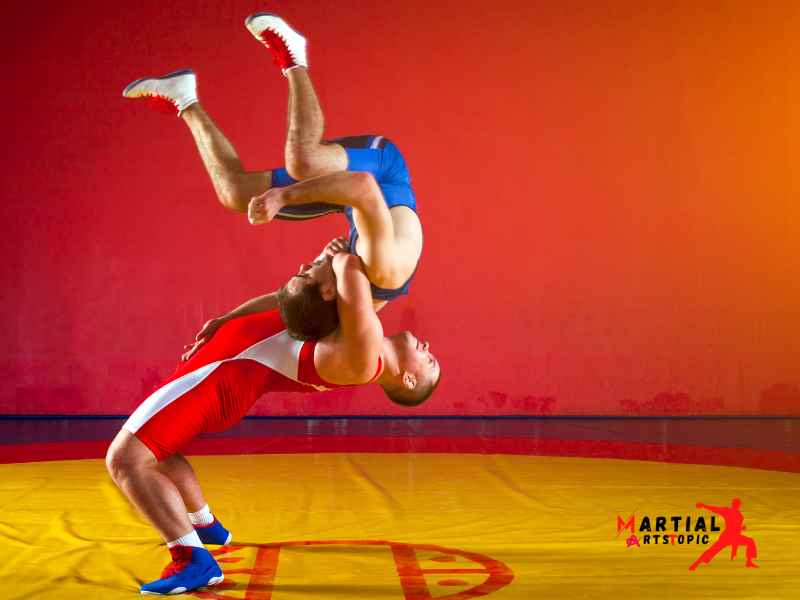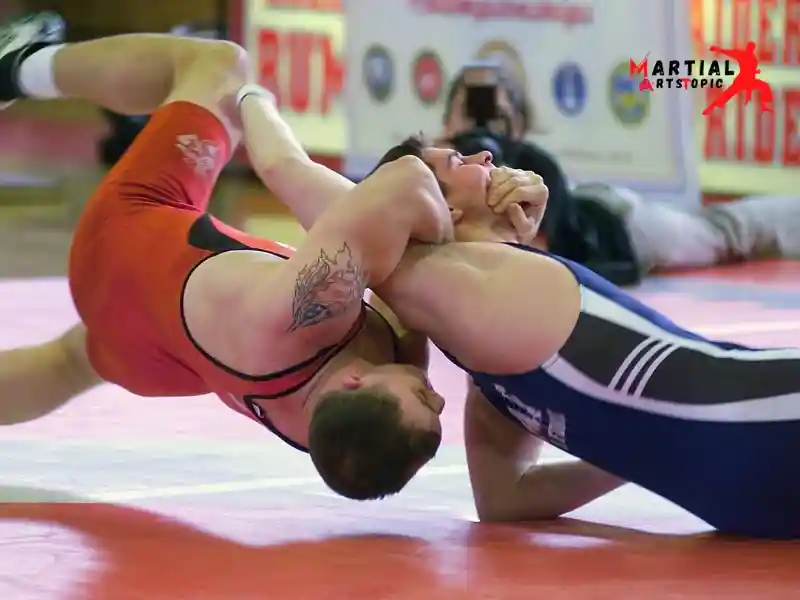
The Ancient Art of Bokh: Traditional Mongolian Wrestling
Bokh, also known as Mongolian Wrestling, is a traditional martial art with deep roots in the history and culture of Mongolia. This ancient form of wrestling has been practiced for centuries and is revered as a symbol of strength, agility, and tradition. Mongolian Wrestling focuses on grappling techniques, throws, and holds, emphasizing the importance of balance, leverage, and timing. The sport also embodies the spirit of honor, respect, and discipline, making it not only a physical endeavor but also a profound cultural experience. As one delves into the world of Mongolian Wrestling, they discover a rich tapestry of tradition, skill, and camaraderie, making it a truly unique and awe-inspiring martial art.
Bokh Mongolian wrestling, also known as Bokh, is a traditional sport that has been an integral part of Mongolian culture for centuries. This ancient form of wrestling is deeply rooted in the history and traditions of Mongolia, and it continues to be a beloved sport that holds great significance in the hearts of the Mongolian people.
Originating from the nomadic lifestyle of the Mongolian people, Bokh reflects the strength, agility, and resilience required for survival on the vast steppes of Mongolia. It is not just a sport, but a way of life that embodies the values of honor, discipline, and respect.
The Rules and Techniques of Mongolian Wrestling

In Mongolian wrestling, the objective is to throw your opponent to the ground using skillful techniques and strategic movements. The wrestlers, known as “Bokh” or “Bokhchi,” wear traditional attire consisting of tight-fitting, open-fronted jackets, and shorts. The wrestling matches take place in a designated area called the “Bokhchuluun,” which is a circular field marked by a symbolic rope.
One of the most distinctive features of Mongolian wrestling is the absence of weight classes, allowing wrestlers of all sizes to compete against each other. This emphasizes the importance of technique, balance, and agility over sheer strength, making it a unique and inclusive sport.
The Importance of Tradition and Ritual
Mongolian wrestling is not just about physical prowess; it is also steeped in tradition and ritual. Before each match, the wrestlers perform a ceremonial dance known as the “Eagle Dance,” which is believed to invoke the spirit of the eagle, a revered symbol of strength and freedom in Mongolian culture.
The wrestlers also observe strict etiquette and rituals, including respectful gestures and gestures of fair play towards their opponents and the audience. These traditions serve to honor the sport’s rich heritage and emphasize the values of humility, integrity, and camaraderie.
Preserving the Legacy of Bokh
In recent years, efforts have been made to preserve and promote the practice of Mongolian wrestling both within Mongolia and around the world. Traditional wrestling festivals and competitions are held regularly, attracting participants and spectators from diverse backgrounds who share a passion for this ancient art form.
Furthermore, modern adaptations of Bokh have been developed to make the sport more accessible to a wider audience, including international competitions and exhibitions that showcase the unique techniques and cultural significance of Mongolian wrestling.
Embracing the Spirit of Bokh
For those who seek to delve into the world of traditional Mongolian wrestling, Bokh offers a glimpse into a proud and resilient culture that continues to uphold its heritage through the practice of this ancient sport. Whether as a spectator or a participant, experiencing the grace, strength, and camaraderie of Mongolian wrestling is an opportunity to connect with a timeless tradition that transcends borders and speaks to the universal human spirit.
The Basics of Mongolian Wrestling
Mongolian wrestling, also known as “Bökh,” is a traditional form of wrestling that has been practiced in Mongolia for centuries. It is a deeply ingrained part of Mongolian culture, often showcased during the annual Naadam festival. This style of wrestling emphasizes technique, strength, and agility, with matches typically taking place on open grassy fields. The wrestlers, known as “bökh” or “bökhchin,” wear traditional tight-fitting costumes and engage in intense, yet graceful, bouts. The sport is steeped in tradition and holds a significant place in the hearts of the Mongolian people, reflecting their history and values. If you’re interested in exploring a unique and time-honored form of wrestling, delving into the basics of Mongolian Wrestling can be a fascinating journey.
Basic Techniques of Mongolian Wrestling

One of the most distinctive features of Mongolian wrestling is the traditional costume worn by the wrestlers. The outfit consists of tight-fitting shorts known as “shuudag” and a pair of open-fronted jackets called “zodog.” These unique garments allow for maximum mobility and agility during matches.
The objective of Mongolian wrestling is to force your opponent to touch the ground with any part of their body other than their feet or hands. This can be achieved through a variety of techniques, including throws, trips, and holds. Wrestlers must also demonstrate strength, balance, and strategy as they engage in intense bouts of physical combat.
Cultural Significance of Mongolian Wrestling
Mongolian wrestling plays a vital role in preserving the cultural heritage of Mongolia. It is a central feature of traditional festivals and celebrations, such as Naadam, where skilled wrestlers from across the country compete for honor and recognition. The sport is also a source of national pride, with dedicated fans and enthusiasts who passionately support their favorite wrestlers.
Besides its cultural importance, Mongolian wrestling promotes values such as discipline, respect, and perseverance. It serves as a platform for individuals to showcase their athleticism and dedication, inspiring younger generations to uphold the traditions of this ancient martial art.
Learning Mongolian Wrestling
If you’re interested in delving deeper into the world of Mongolian wrestling, consider seeking out a qualified instructor or joining a local club or gym that offers training in this traditional sport. Besides physical fitness, learning Mongolian wrestling can provide a unique cultural experience and a deeper understanding of Mongolian traditions.
What is Mongolian Wrestling?
What is Mongolian Wrestling? Mongolian wrestling, also known as “Bökh,” is a traditional style of wrestling that has been practiced for centuries in Mongolia. It is deeply rooted in the country’s history and culture, with strong ties to nomadic traditions and warrior customs. The sport involves a unique combination of strength, agility, and technique, as wrestlers wear traditional open-front jackets and attempt to throw their opponents to the ground. Bökh is not just a physical contest but also a display of honor, respect, and sportsmanship. The sport has gained international recognition and is a source of national pride for Mongolians. If you’re looking to explore the rich cultural heritage of Mongolia and experience a unique form of wrestling, then Mongolian Wrestling is definitely worth exploring.
Origins and History
Mongolian wrestling, also known as Bökh, has a rich and fascinating history that dates back centuries. Originating from the nomadic lifestyle of the Mongolian people, Bökh has been an integral part of their culture, serving as both entertainment and a way to showcase strength and agility. The sport is deeply rooted in the traditions of the Mongolian people, with its origins intertwined with their nomadic way of life and the importance of physical prowess in their society. Understanding the origins and history of Mongolian wrestling provides valuable insights into the cultural heritage and traditions of the Mongolian people, making it an intriguing subject for enthusiasts of martial arts and cultural history alike.
Origins of Mongolian Wrestling:
Mongolian wrestling traces its origins to the ancient nomadic lifestyle of the Mongolian people. As early as the time of Genghis Khan and the Mongol Empire, wrestling played a significant role in the lives of the warriors and the general population. It was not just a sport, but a way to demonstrate strength, agility, and honor.
The sport was initially practiced as military training, with soldiers honing their physical prowess through wrestling. Over time, it transitioned into a popular form of entertainment and a means of resolving disputes and conflicts within the community.
Evolution of the Sport over the Centuries
Over the centuries, Mongolian Wrestling has undergone significant transformations, transitioning from a military training exercise to a revered traditional sport. The sport became a popular form of entertainment during festive occasions, such as Naadam, the annual national festival of Mongolia. During Naadam, Mongolian Wrestling takes center stage, showcasing the strength, agility, and skill of the participants.
The evolution of Mongolian Wrestling also reflects the cultural and societal changes within Mongolia. As the sport gained popularity, rules and regulations were established to standardize the competitions. The traditional attire, including the tight-fitting, open-fronted jacket known as “zodog,” and the shorts, known as “shuudag,” became iconic symbols of the sport.
Today, Mongolian Wrestling continues to thrive as a cherished tradition, deeply ingrained in the cultural fabric of Mongolia. It has also garnered international recognition, with efforts to preserve and promote the sport on a global scale.
Basic Techniques and Movements

Mongolian Wrestling, also known as Bökh, is a traditional martial art that emphasizes grappling and takedowns. The fundamental techniques and movements of Mongolian Wrestling are rooted in centuries of cultural heritage and are essential for mastering this formidable martial art. Beginners can start by learning basic stances, footwork, and grips, which form the foundation for executing effective throws and takedowns. By consistently practicing these fundamental techniques, practitioners can build a solid skill set and develop a deep understanding of the art of Mongolian Wrestling. Whether you’re new to martial arts or seeking to expand your repertoire, mastering these basic techniques is crucial for progressing in the art of Bökh.
- Stance and Footwork: The foundation of Mongolian Wrestling lies in the wrestler’s stance and footwork. Wrestlers typically stand with their feet shoulder-width apart, maintaining a low center of gravity for stability. The footwork involves subtle movements that allow wrestlers to maintain balance and maneuver effectively during a match.
- Grip and Control: Gripping techniques are crucial in Mongolian Wrestling, as they enable wrestlers to gain control over their opponent. Wrestlers use a combination of overhand and underhand grips to secure their opponent’s body and clothing, strategically positioning themselves for takedowns and throws.
- Takedowns and Throws: Mongolian Wrestling emphasizes powerful takedowns and throws that showcase the wrestler’s strength and technique. Techniques such as the “knee block” and “hip throw” are commonly employed to off-balance the opponent and execute dynamic throws with precision.
- Defense and Counter-Attacks: Effective defense is essential in Mongolian Wrestling, requiring wrestlers to anticipate their opponent’s movements and react swiftly. Wrestlers utilize evasive footwork, strategic positioning, and timely counter-attacks to neutralize their opponent’s offensive maneuvers.
- Groundwork and Submission Holds: When the match transitions to the ground, wrestlers engage in groundwork to gain leverage and control. Submission holds such as joint locks and chokes are used to force the opponent into a position of surrender, adding a strategic dimension to the art of Mongolian Wrestling.
- Mindset and Discipline: Beyond the physical techniques, Mongolian Wrestling cultivates a mindset of discipline, respect, and perseverance. Wrestlers are encouraged to embody the values of fair play and humility, honoring the traditions of the ancient art form.
Gripping Techniques
One of the most crucial aspects of Mongolian Wrestling is mastering the art of gripping. The grip serves as the initial connection between you and your opponent, dictating the flow of the match. The “Sukhbaatar” grip, where the wrestlers interlock their fingers and grasp each other’s outer garment, is a fundamental technique that demands both strength and dexterity.
Training and Preparation
When it comes to preparing for Mongolian Wrestling, training is essential. A combination of strength, agility, and technique is required to excel in this traditional form of wrestling. Conditioning exercises such as running, bodyweight exercises, and grappling drills can help improve overall performance. It’s also important to focus on flexibility and balance to adapt to the dynamic nature of Mongolian Wrestling. Mental preparation is equally important, as wrestlers need to develop focus, determination, and strategic thinking. Consistent training and dedication are key to mastering the skills necessary for success in Mongolian Wrestling.
Training Tips of Mongolian Wrestling
- Understand the Fundamentals: Before diving into intense training, it’s crucial to have a solid understanding of the fundamental techniques and rules of Mongolian Wrestling. Take the time to study the traditional holds, grips, and takedowns, as well as the scoring system used in competitions.
- Strengthen Your Body: Mongolian Wrestling requires a great deal of physical strength and endurance. Incorporate strength training exercises such as squats, deadlifts, and kettlebell swings into your workout routine to build the power needed for grappling and throwing opponents.
- Focus on Flexibility: Flexibility is key in Mongolian Wrestling, as it allows for greater range of motion and agility during matches. Incorporate regular stretching and mobility exercises to improve your flexibility and prevent injuries on the mat.
- Practice Traditional Techniques: Find a qualified instructor or training partner who can teach you the traditional techniques of Mongolian Wrestling. Practice takedowns, throws, and groundwork regularly to hone your skills and develop muscle memory for effective execution during matches.
- Mental Preparation: besides physical training, mental preparation is essential for success in Mongolian Wrestling. Develop a strong mindset, focus on mental toughness, and visualize yourself executing techniques with precision and confidence.
- Spar and Compete: Put your skills to the test by sparring with training partners and participating in local competitions. This will not only help you gain practical experience but also expose you to different styles and strategies used by fellow practitioners.
- Study Opponents: Take the time to study the techniques and tendencies of your opponents. Understanding their strengths and weaknesses can give you a competitive edge and help you develop effective counter-strategies.
- Embrace the Tradition: Embrace the rich cultural and historical significance of Mongolian Wrestling. Immerse yourself in the traditions, rituals, and values associated with this ancient martial art, and let them inspire and guide your training journey.
Benefits of Practicing Bokh: Traditional Mongolian Wrestling

Practicing Bokh, also known as Mongolian Wrestling, offers a wide range of physical and mental benefits. This traditional form of wrestling provides an excellent full-body workout, improving strength, agility, and endurance. Additionally, Bokh promotes discipline, focus, and mental resilience, which are essential qualities not only in the sport itself but also in everyday life. Furthermore, the deep-rooted cultural and historical significance of Bokh adds a rich layer of tradition and heritage to the practice, making it a deeply rewarding experience for participants. With its emphasis on physical fitness, mental fortitude, and cultural connection, Bokh is a holistic martial art that offers numerous advantages for those who embrace it.
- Physical Fitness: Engaging in Bokh training is an excellent way to enhance your physical fitness. The rigorous movements, including grappling, throwing, and striking, provide a full-body workout, improving strength, endurance, and flexibility. By regularly practicing Bokh, you can develop a strong physique.
- Mental Discipline: Bokh is not just about physical prowess; it also fosters mental discipline. The training emphasizes focus, self-control, and strategic thinking. As you immerse yourself in the art of Mongolian wrestling, you’ll sharpen your mental acuity and develop a resilient mindset that extends beyond the training mat.
- Cultural Enrichment: Embracing Bokh means delving into the rich cultural heritage of Mongolia. This traditional form of wrestling has been a cornerstone of Mongolian culture for centuries, with deep-rooted traditions and rituals. By participating in Bokh, you’ll gain a profound appreciation for the cultural significance of this martial art.
- Stress Relief: In today’s fast-paced world, stress and anxiety are common challenges. Bokh offers a unique outlet for releasing pent-up stress and tension. The physical exertion and mental focus required during training can provide a therapeutic release, leaving you feeling rejuvenated and balanced.
- Community and Camaraderie: Training in Bokh often takes place within a supportive community of practitioners. This creates a sense of camaraderie and mutual respect among fellow wrestlers. The bonds formed through training and competition can lead to lasting friendships and a strong sense of belonging.
- Self-Defense Skills: Beyond its cultural and physical benefits, Bokh equips practitioners with practical self-defense skills. The techniques and strategies learned in Bokh training can be invaluable for personal safety and security in real-world situations.
- Character Development: The practice of Bokh instills valuable character traits such as perseverance, humility, and fair play. Whether in victory or defeat, the lessons learned on the wrestling mat can shape individuals into resilient, respectful, and honorable individuals.
10 Reasons Why You Should Try Mongolian Wrestling as a Martial Art

If you’re looking for a unique and traditional martial art to try, Mongolian Wrestling, also known as “Bökh,” might be the perfect fit for you. This ancient form of combat has a rich cultural heritage and offers a plethora of benefits for both physical and mental well-being. From building strength and agility to cultivating discipline and respect, there are numerous reasons why you should consider exploring the world of Mongolian Wrestling. Whether you’re drawn to its historical significance, the opportunity to learn from experienced practitioners, or simply the thrill of mastering new techniques, this dynamic martial art has something to offer for everyone. So, if you’re ready to embark on a rewarding and exciting journey, delving into the realm of Mongolian Wrestling could be the next step in your martial arts odyssey.
- Cultural Enrichment: Embracing Mongolian Wrestling allows you to immerse yourself in the rich heritage and traditions of Mongolia. You’ll can connect with a culture that deeply values physical strength, discipline, and respect.
- Physical Fitness: Engaging in Mongolian Wrestling provides an excellent full-body workout. It enhances strength, endurance, agility, and flexibility, promoting overall physical fitness.
- Mental Discipline: The practice of Mongolian Wrestling instills mental discipline, focus, and resilience. It requires strategic thinking and the ability to anticipate your opponent’s moves, promoting mental sharpness.
- Unique Techniques: Mongolian Wrestling encompasses a set of unique grappling and throwing techniques that are distinct from other forms of wrestling. Learning these techniques can broaden your martial arts repertoire and enhance your skills.
- Community and Camaraderie: Joining a Mongolian Wrestling club or class can introduce you to a supportive community of practitioners who share a passion for the art. The camaraderie and mutual support among practitioners create a positive and encouraging training environment.
- Practical Self-Defense: The techniques learned in Mongolian Wrestling can be applied to real-life self-defense situations. By mastering the art’s grappling and throwing techniques, you can develop valuable skills for protecting yourself if the need arises.
- Cultural Exchange: Participating in Mongolian Wrestling opens the door to cultural exchange opportunities. You may have the chance to engage with Mongolian practitioners, learn from their experiences, and gain insights into their cultural perspectives.
- Competitive Opportunities: For those interested in competitive sports, Mongolian Wrestling offers a platform to compete in local, national, and international tournaments. It presents an avenue to challenge yourself and showcase your skills at a competitive stage.
- Mental and Emotional Resilience: The rigorous training and competitive nature of Mongolian Wrestling can contribute to the development of mental and emotional resilience. Overcoming challenges in training and competitions can build confidence and inner strength.
- Personal Growth: Engaging in Mongolian Wrestling can foster personal growth and self-improvement. It encourages you to push your boundaries, set and achieve goals, and continuously strive for excellence in both physical and mental aspects.
Conclusion
Mongolian Wrestling, also known as Bökh, is a unique and ancient form of martial arts that reflects the rich cultural heritage of Mongolia. With its emphasis on strength, agility, and technique, Bökh serves as a testament to the traditional values and fierce spirit of the Mongolian people. As practitioners continue to preserve and promote this art form, it stands as a symbol of resilience and tradition in the modern world. Whether as a participant or an admirer, embracing the principles of Bökh can inspire individuals to embody determination, discipline, and respect both on and off the mat.
